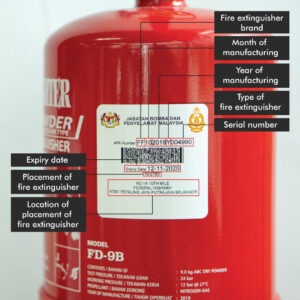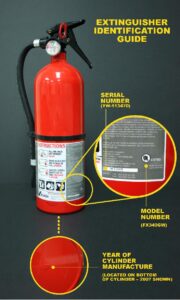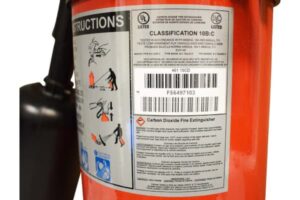As an Amazon Associate I earn from qualifying purchases.
Decoding the Number: Understanding the Meaning behind Fire Extinguisher Lavels
As an adept writer, I’m here to illuminate the significance of Fire extinguisher labels. These labels are indispensable for any facility, be it residential, commercial, or industrial. They offer crucial insights into the type of extinguisher, its intended use, and safety instructions. Let’s delve into another aspect of fire safety to ensure clarity and understanding for all.
In this comprehensive guide, we’ll delve into the intricate world of fire extinguisher labels. We’ll discuss their pivotal role in fire safety, explore various types of extinguishers along with their corresponding labels, decipher the numerical codes on the labels, understand the significance of label colors and symbols, address prevalent misconceptions, learn the art of reading and interpreting these labels effectively, and delve into the crucial task of maintaining and inspecting fire extinguishers based on the information provided on their labels. Let’s embark on this enlightening journey to enhance our understanding of fire safety protocols.
Introduction to Fire Extinguisher Labels
Fire extinguisher labels are crucial elements for any type of facility as they provide vital information about the type of extinguisher and how to use it safely.
Typically, these labels contain information about the type of extinguisher, what it can be used to combat, and how to use it safely. Additionally, the labels also include details about the maintenance and inspection of the extinguisher.
Understanding the information provided on fire extinguisher labels is essential for ensuring fire safety in various settings. By following the guidelines outlined on these labels, individuals can effectively combat fires while minimizing risks to themselves and others.
The Importance of Understanding Blaze Extinguisher Labels
Understanding the extinguisher labels is extremely important as it can help prevent fires and save lives. extinguisher labels provide information about the type of fire extinguisher, what it can be used to combat, and how to use it safely. Additionally, the labels also provide information about the maintenance and inspection of the fire extinguisher.
Types of Fire Extinguishers and Their Labels
There are several types of extinguishers, each designed to combat different types of fires. The most common types of fire extinguishers include:
- Water extinguishers
- Foam extinguishers
- Carbon dioxide (CO2) extinguishers
- Dry chemical powder extinguishers
- Class K fire extinguishers (for kitchen fires)
Each type of fire extinguisher has a label that provides important information about the type of fire it can be used to combat.

Ratings for the size of fire extinguishers
Have you ever seen a fire extinguisher with a label that reads something like 4A:20B: C? These numbers show how big the fire-fighting substance is. This is the basic idea:
- The volume of water has been represented by a Class A size rating. Each number here indicates an amount equal to one and one-fourth gallons of water. For example, 2A implies that if one needs a bottle-full of two plus one half-gallon bottles So they should just grab 2A). 4A would mean you require five gallons respectively.”
- A Class B size rating represents the number of feet a fire extinguisher covers with chemicals when discharged. The extinguishing agent contained in the canister is sufficient enough to spread across an area of 20 square feet if the nozzle is swept sideways.
- As for Class C fires, it is rated under any size category since it merely constitutes a Class A or B fire where the equipment has been energised thus requiring a nonconductive extinguishing media. In selecting extinguishers to fight Class C fires well, the choice should be based on fire extinguisher size rating classes A and B.
- Unlike for class D fires, size ratings are lacking on them. The label includes how well it works in fighting fires involving a particular type of combustible metal that it is made for
Understanding the Meaning Behind Extinguisher Label Colors
The colors of extinguisher labels are standardized and provide important information about the type of fire extinguisher and the type of fire it can be used to combat. The label colors are as follows:
- Red: Water extinguishers
- Cream: Foam extinguishers
- Black: CO2 extinguishers
- Blue: Dry chemical powder extinguishers
- Yellow: Class K extinguishers (for kitchen fires)
Symbols on Fire Extinguisher Labels and Their Significance
In addition to numbers and colors, fire extinguisher labels also feature symbols that provide important information about the type of the extinguisher can combat. Some of these symbols include:
- Flame symbol: Indicates that the extinguisher is suitable for fighting fires with flames.
- Electrical outlet symbol: Indicates that the extinguisher is suitable for fighting electrical fires.
- Stove symbol: Indicates that the extinguisher is suitable for fighting kitchen fires.
Common Misconceptions about Extinguisher Labels
There are many common misconceptions about extinguisher labels, such as the belief that all extinguishers are the same. It’s important to understand that each type of extinguisher is designed to combat a specific type of fire, and the labels provide important information about the type of fire it can combat.

How to Read and Interpret Extinguisher Labels
Reading and interpreting extinguisher labels is essential to ensure the correct use of extinguishers and the safety of people and property. It’s important to read the labels carefully and understand the information provided about the type of extinguisher, what it can be used to combat, and how to use it safely.
Additionally, the labels also provide important information about the maintenance and inspection of the extinguisher.
Maintenance and Inspection of Fire Extinguishers Based on Label Information
Fire extinguisher labels provide important information about the maintenance and inspection of extinguishers. It’s important to follow the instructions provided on the labels to ensure that the extinguishers are always in good working condition. Regular maintenance and inspection of extinguishers are essential to ensure the safety of people and property.
Patching Up
Extinguisher labels are a critical element for any type of facility as they provide important information about the type of fire extinguisher and how to use it safely. It’s important to understand extinguisher labels to prevent fires and save lives. Always remember to read and interpret the labels carefully and follow the instructions provided to ensure that the extinguishers are always in good working condition.
Amazon and the Amazon logo are trademarks of Amazon.com, Inc, or its affiliates.



Hi this is a good 🌟 review
I am sure this piece of writing has touched all the
internet people, its really really pleasant post on building up new blog.
Hello there! This article could not be written much better!
Going through this post reminds me of my previous roommate!
He constantly kept talking about this. I am going to send this information to him.
Fairly certain he’s going to have a good read. Thank you for sharing!
It’s very interesting! If you need help, look here: ARA Agency